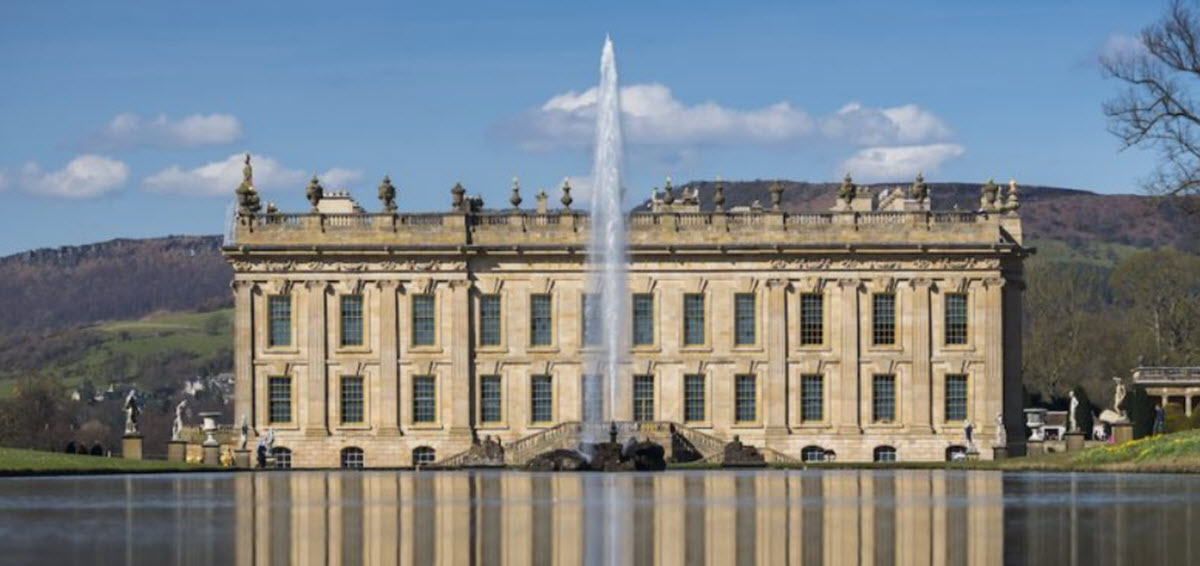Contents
Standing on the east bank of the River Derwent, Chatsworth House in Derbyshire has been home to the Cavendish family since 1549. This stately home, which is the seat of the Duke of Devonshire, is set in a large parkland and backed by wooded, rocky hills that rises to the heather moorland above. The house looks onto the low hills between the Derwent and Wye valleys. Chatsworth House is built on sloping ground, which is lower to the north and west.
The house has its roots in a Tudor mansion built in the 1560s. This mansion, built by Bess of Hardwick, had a quadrangle layout with a large central courtyard. Even though the current manor house has its origins in a Tudor mansion, a lot has of course been changed since then. William Cavendish, 1st Duke of Devonshire, did, for instance, rebuild the south and east fronts, a project helmed by the architect William Talman and completed in 1696.

Where is it located?
Chatsworth House is located in the Derbyshire Dales in England, roughly 9 miles (14 km) west of the town Chesterfield.
Is it open to the public?
Part of the Chatsworth House is open to visitors, but nearly 100 of the 126 rooms are kept private for the resident family. Chatsworth House is a popular place to visit and has been voted Britain´s favourite country house several times.
Short facts about Chatsworth House
Location: Derbyshire, England, UK
Coordinates: 53°13′40″N 1°36′36″W
Elevation: 125 meters (410 ft)
Architectural style: English Baroque, Italianate
Owner: Trustees of the Chatsworth Settlement (who are leasing the house to the Chatsworth House Trust)
Listing: Listed Building – Grade I. Designated in 1951. Reference 1373871.
Chatsworth House in the 21st century
When the 11th Duke of Devonshire died in 2004, he was succeeded by his son Peregrine Cavendish, who thus became the 12th Duke of Devonshire. A structural survey of the house carried out that same year reveal a strong need for a major renovations. Carried out in 2008-2018, the renovations cost £32 million and included – among other things – restoration of stonework and statues. The 11th Duke´s widow, Deborah Vivien Cavendish, continued to be very active in the affairs of the house until her death in 2014.
Background and early history
Why is it called Chatsworth?
The name Chatsworth comes from Chetel´s-worth, which means “The Court of Chetel”. In the reign of Edward the Confessor, a man of Norse origin named Chetel held lands here; Ednesoure to the west of the Derwent, and Langoleie and Chetesuorde to the east. Chetel was deposed after the Norman Conquest. In the Domesday Book (completed in 1086), the Manor of Chetesourde is listed as owned by the Crown and being in the custody of William the Peverel. The manor would not be a large estate again until the 1400s.
The house built by the Leches
In the 1400s, the Leche family – who owned property in the region – acquired Chetesourde / Chatsworth. The Leches built a house and enclosed the first park at Chatsworth. The house was built on an area of high ground that is nowadays a part of the garden.
The house built by the Cavendish
Chatsworth stayed with the Leche family until 1549, when all their holdings in the area were purchased by Sir William Cavendish. He was the Treasurer of the King´s Chamber, and it was his wife Elizabeth (“Bess of Hardwick”) who had convinced him to leave Suffolk and settled down in this region instead.
In 1553, Bess of Hardwick selected a spot near the river at Chatsworth and had a series of reservoirs dug out to drain it. (These reservoirs were then turned into fish ponds.) On her selected spot, she had a new house built, a project that continued into the 1560s.
Sir Cavendish died in 1557. When Bess remarried, her new husband – George Talbot, 6th Earl of Shrewsbury – moved into the new Chatsworth House and lived there with her.
After Bess´ death in 1608, her eldest son Henry Cavendish inherited Chatsworth House. He soon sold it to his brother William Cavendish, who later became the 1st Earl of Devonshire. The purchase prize was £10,000.
